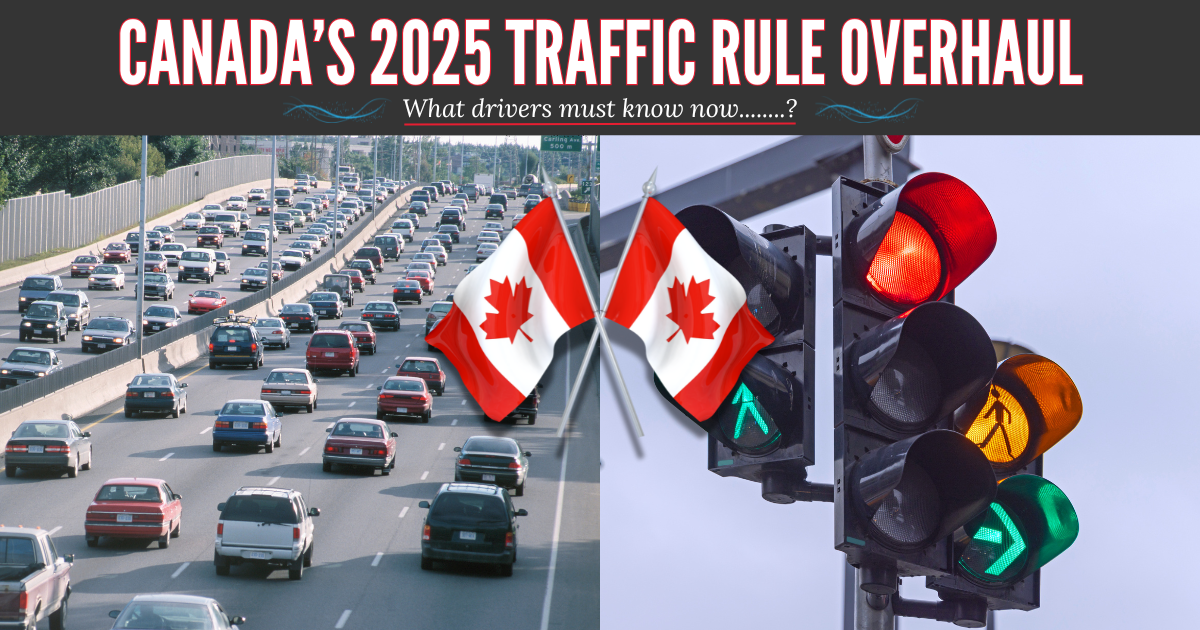Canada’s 2025 traffic rule overhaul: What drivers must know now. The new traffic rules in Canada will be implemented from July 1, 2025, under the New Canada Driving Law 2025. There will be some significant changes made that will take effect in 2025. The rules will be made for drivers, and if the driver does not follow the rules, he will have to pay a penalty fee or may even get imprisonment for big mistakes. To know more about the topic, “Canada’s 2025 traffic rule overhaul: What drivers must know now, read the complete article.
Canada’s 2025 Traffic Rule Overhaul
The traffic rule overhaul will be implemented from July 1, 2025, under the New Canada Driving Law 2025, to ensure the safety of Canadians. This countrywide initiative comprises stricter penalties, modern safety standards, and advanced enforcement technologies to enhance road safety and adapt to evolving transportation difficulties. This is not a routine update, as the drivers across provinces will face stricter regulations, upgraded safety requirements, and higher penalties for violations.

The declaration in early May 2025 confirms that the objective of the new laws is to minimize road fatalities, enhance driver responsibility, and adapt to modern transportation challenges. One of the most important additions under the new traffic law includes obligatory use of advanced driver-assistance systems (ADAS) in new vehicles sold from July 2025 onwards. This aligns with global safety standards and motivates manufacturers to push forward innovations in crash avoidance.
What Drivers Must Know Now
Mandatory Advanced Driver-Assistance Systems (ADAS)
All new cars sold in Canada starting in July 2025 have to have ADAS features like adaptive cruise control, automated emergency braking, and lane-keeping assistance. This move aligns with international safety standards and encourages manufacturers to innovate in crash prevention technologies. For owners of old vehicles, the government will provide retrofit incentives and detailed guidelines to encourage the adoption of ADAS features.
Stricter Distracted Driving Laws
Expanded Definition: The law also defines new categories of distraction, including smart glasses and wrist-wearables. This have been increasingly linked to driver inattention.
National Ban on Handheld Devices: It’s illegal to use your phone or any other handheld device while you’re driving or stopped at a red light. However, you are allowed to use a hands-free wireless device with an earpiece or Bluetooth.
Harsher Penalties: Dangerous driving is a serious criminal offense with harsher penalties. It includes jail terms up to ten years for causing injury or up to 14 years for causing death.
Lowered Impaired Driving Thresholds
Reduced BAC Limit: Responding to increased cannabis- and alcohol-related crashes, Alberta and Quebec have lowered their legal blood alcohol concentration (BAC) limits:
- Old limit: 0.08
- New limit (2025): 0.05
Roadside Testing: Police forces across provinces will receive new roadside testing tools to enforce these changes more effectively.
Alcohol Detection: Police will be using dual-mode roadside test kits that detect both alcohol and THC, enhancing enforcement accuracy.
Expanded Pedestrian Protection Zones
The new law broadens federally designated high-risk pedestrian zones, moving above local municipality control. This change guarantees adequate protection for pedestrians in areas with high foot traffic and accident rates.
Impact on Commercial Drivers
Commercial drivers will face tougher regulations under the New Canada Driving Law 2025. Electronic logging devices (ELDs) with real-time GPS tracking will be used to comply with updated Hours of Service (HOS) regulations. Violations related to driver tiredness will result in financial penalties and compulsory retraining courses.
Eco Driving Education
In line with Canada’s environmental goals, eco-driving education is becoming a condition for accessing zero-emission vehicle rebates. To qualify for both federal and provincial incentives, potentially totaling up to $7,500, drivers will be required to complete a government-approved course.
These courses teach techniques such as smooth acceleration, regenerative braking, and efficient route planning. These new Canadian vehicle laws of 2025 encourage greener habits while improving overall road safety.
Connected and Automated Vehicles (CAVs) Framework
Transport Canada’s Safety Framework for Connected and Automated Vehicles outlines guidelines for the safe deployment of CAV technologies, including
Cybersecurity Measures: Ensuring that CAV systems are protected against cyber threats.
Testing Protocols: Establishing standards for testing and verification of automated driving systems.
Public Engagement: Informing and teaching the public about the advantages and limitations of CAVs.
These initiatives aim to promote the integration of CAVs into Canada’s transportation system while maintaining high safety standards.



